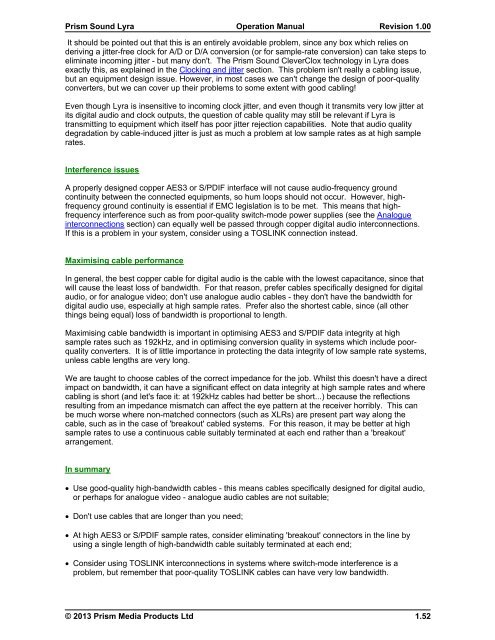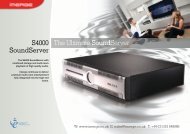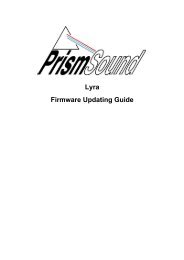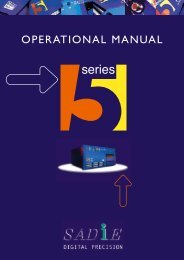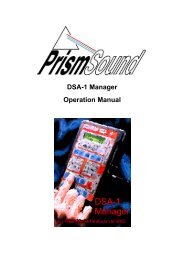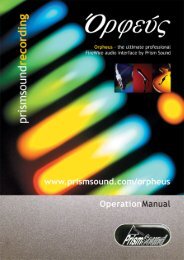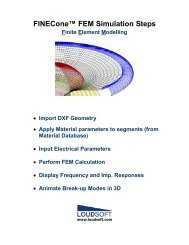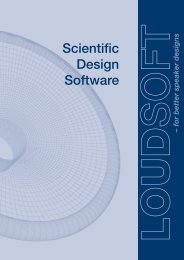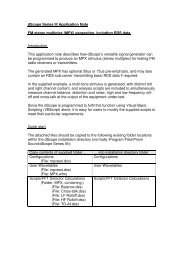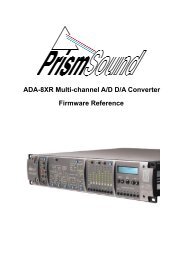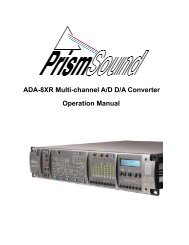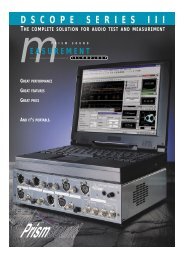Lyra Operation Manual - Test and Measurement - Prism Sound
Lyra Operation Manual - Test and Measurement - Prism Sound
Lyra Operation Manual - Test and Measurement - Prism Sound
- No tags were found...
You also want an ePaper? Increase the reach of your titles
YUMPU automatically turns print PDFs into web optimized ePapers that Google loves.
<strong>Prism</strong> <strong>Sound</strong> <strong>Lyra</strong><strong>Operation</strong> <strong>Manual</strong>Revision 1.00It should be pointed out that this is an entirely avoidable problem, since any box which relies onderiving a jitter-free clock for A/D or D/A conversion (or for sample-rate conversion) can take steps toeliminate incoming jitter - but many don't. The <strong>Prism</strong> <strong>Sound</strong> CleverClox technology in <strong>Lyra</strong> doesexactly this, as explained in the Clocking <strong>and</strong> jitter section. This problem isn't really a cabling issue,but an equipment design issue. However, in most cases we can't change the design of poor-qualityconverters, but we can cover up their problems to some extent with good cabling!Even though <strong>Lyra</strong> is insensitive to incoming clock jitter, <strong>and</strong> even though it transmits very low jitter atits digital audio <strong>and</strong> clock outputs, the question of cable quality may still be relevant if <strong>Lyra</strong> istransmitting to equipment which itself has poor jitter rejection capabilities. Note that audio qualitydegradation by cable-induced jitter is just as much a problem at low sample rates as at high samplerates.Interference issuesA properly designed copper AES3 or S/PDIF interface will not cause audio-frequency groundcontinuity between the connected equipments, so hum loops should not occur. However, highfrequencyground continuity is essential if EMC legislation is to be met. This means that highfrequencyinterference such as from poor-quality switch-mode power supplies (see the Analogueinterconnections section) can equally well be passed through copper digital audio interconnections.If this is a problem in your system, consider using a TOSLINK connection instead.Maximising cable performanceIn general, the best copper cable for digital audio is the cable with the lowest capacitance, since thatwill cause the least loss of b<strong>and</strong>width. For that reason, prefer cables specifically designed for digitalaudio, or for analogue video; don't use analogue audio cables - they don't have the b<strong>and</strong>width fordigital audio use, especially at high sample rates. Prefer also the shortest cable, since (all otherthings being equal) loss of b<strong>and</strong>width is proportional to length.Maximising cable b<strong>and</strong>width is important in optimising AES3 <strong>and</strong> S/PDIF data integrity at highsample rates such as 192kHz, <strong>and</strong> in optimising conversion quality in systems which include poorqualityconverters. It is of little importance in protecting the data integrity of low sample rate systems,unless cable lengths are very long.We are taught to choose cables of the correct impedance for the job. Whilst this doesn't have a directimpact on b<strong>and</strong>width, it can have a significant effect on data integrity at high sample rates <strong>and</strong> wherecabling is short (<strong>and</strong> let's face it: at 192kHz cables had better be short...) because the reflectionsresulting from an impedance mismatch can affect the eye pattern at the receiver horribly. This canbe much worse where non-matched connectors (such as XLRs) are present part way along thecable, such as in the case of 'breakout' cabled systems. For this reason, it may be better at highsample rates to use a continuous cable suitably terminated at each end rather than a 'breakout'arrangement.In summary· Use good-quality high-b<strong>and</strong>width cables - this means cables specifically designed for digital audio,or perhaps for analogue video - analogue audio cables are not suitable;· Don't use cables that are longer than you need;· At high AES3 or S/PDIF sample rates, consider eliminating 'breakout' connectors in the line byusing a single length of high-b<strong>and</strong>width cable suitably terminated at each end;· Consider using TOSLINK interconnections in systems where switch-mode interference is aproblem, but remember that poor-quality TOSLINK cables can have very low b<strong>and</strong>width.© 2013 <strong>Prism</strong> Media Products Ltd1.52


